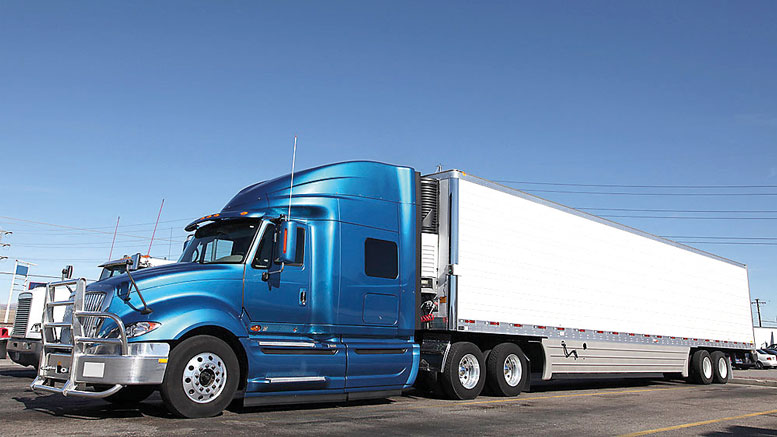COVID’s Impact on Transportation
September 30, 2020 | 9 min to read
The article discusses how COVID-19 has dramatically impacted the over-the-road transport of produce in the United States and Canada, leading to historic price increases of 15% to 25%. Despite higher costs and scheduling challenges, the quality of produce has remained intact. Truckers face increased demands, including limited access to loading docks and rest stops, while companies adapt by enhancing communication and support for drivers. Overall, the combination of supply constraints and health concerns complicates logistics in the produce industry.

Originally printed in the September 2020 issue of Produce Business.
Though product quality has not suffered, limited capacity of truckers and scheduling demands have caused historic price increases.
How has COVID-19 changed over-the-road transport of produce in the United States and Canada? Hint: it hasn’t made things any easier.
In fact, from higher costs and inconsistent access to some regions to slowdowns, scheduling and attendance issues, and a host of employee safety (see sidebar) and training concerns, moving produce from state to state is often more arduous a task than ever.
The industry is coping
Tracey Lewin, vice president of Branch Operations for Allen Lund Co. in Flintridge, CA, points out, “Almost all modes of transportation—dry van, refrigerated, flatbed, rail—have had significant freight cost increases since mid-April. I think it’s safe to say that the refrigerated sector has been hit the hardest and for the longest period without relent.”



Flintridge, CA-based Allen Lund Co.’s transportation division includes (L-R) Bob Rose, vice president of Produce Sales; Tracey Lewin, vice president of Branch Operations; and Lenny Sciarappa, Lund’s vice president of Branch Operations.
How much more expensive transportation has become, says Lenny Sciarappa, Lund’s vice president of Branch Operations, “is a difficult question to answer because available capacity has varied by lane. Our estimates are that rates have increased anywhere between 15% and 25% overall.” To manage the additional cost, adds Bob Rose, the company’s vice president of Produce Sales, “We have taken on extra capacity, and our clients have supported those efforts to get their products to market.”
Whether or not produce quality has suffered, and if so how much, remains an open question. “From where we sit, it’s hard to say definitively one way or another,” Lewin says. “However, based on the fact that we don’t seem to be seeing a higher number of rejections at the receivers, it doesn’t seem quality has been affected during this time.”
Spiked
Evan Kazan, director of business development for 39-year-old Target Interstate Systems, Inc. in the Bronx, NY, confirms that transportation has, indeed, gotten more expensive since the onslaught of COVID-19. “When the pandemic started, the rates spiked considerably, and have maintained high throughout.”
The initial jump in costs, Kazan explains, was brought about by several factors. “First, when the New York area was the initial epicenter, there was a considerable reluctance by drivers to come to the Northeast and, more specifically, New York.” Drivers wanted a rate premium for the risk—if they’d consider the load at all. Next, once trucks delivered their produce loads, there was, he says, “virtually no freight being shipped for them to get a load back to, say, California.”
When the pandemic started, truckers would have to wait seven to 10 days or longer, and when they got a backhaul, they found they were being paid 30% or more less than usual.
Carriers would typically wait from one to three days for the next load, depending on their hours and ability to find backhauls. When the pandemic started, however, they would have to wait seven to 10 days or longer, and when they got a backhaul they found they were being paid 30% or more less than usual. “This increased their break-even costs per trip due to the reduced number of trips, and reduced backhaul rates.” Carriers passed the expense to their rate for the produce loads.
If restaurants had remained open during the early parts of the pandemic, Kazan suggests, the industry would have seen even higher rates. “Even with an entire sector of the industry shut down, freight rates increased 20% or more in March 2020 compared to March 2019, and it has only grown.” Rates in August, which are typically low for long-haul produce due to the availability of local produce, saw an increase of 35% from 2019 to 2020.
Kazan echoes Lewin in saying that he and his colleagues have not yet noticed any decrease in produce quality due to the pandemic, “but others might be better suited to answer that. I can say that we have seen no material change in the number of inspections or claims on product in recent months.”
More Demanding
It goes without saying that things have become more demanding for the truckers. “It’s not easy for many of the trucking companies today with Covid concerns and supply constraints,” Rose laments. “Our drivers are not allowed on many docks to check the products before loading. There is more of a need for good communication from the shipper community to the trucking companies in these times.”
That’s not all. At the beginning of the pandemic, Kazan recalls, many rest stops and travel centers would not allow trucks inside their buildings, or they were closed all together. “It made it difficult for drivers to refuel, get food, or practice proper hygiene. Many of them reversed course, but it was very difficult for a period.”
Scheduling and delivery times have similarly been impacted, Rose adds. “We are seeing issues where we are covering for trucking companies that cannot pick up loads and spending more time scheduling deliveries that fit the needs of the customer and the truckers.”
Kazan reports that there have been no material changes to scheduling and hours of service. The federal government suspended some rules to allow carriers to drive more freely, and get essential goods through the supply chain to prevent disruption. “But overall, things remained the same.”
“Even with an entire sector of the industry shut down, freight rates increased 20% or more in March 2020 compared to March 2019, and it has only grown.”
— Evan Kazan, Target Interstate
When times are as challenging as they have become, Sciarappa warns, “people have a tendency to get discouraged, and the service we provide our customers can be affected negatively. For those of us who lead, it’s important we stay positive and project that image to our teams. It is our responsibility to keep morale high and motivate our people to provide the service that our customers expect and deserve. We must remind them that they should be proud of the service they provide to keep fresh fruit and vegetables on tables across our great country.”
Capacity has not kept up with the increased demand in volume since April, Lewin notes. “There are certain areas of the country that have been more problematic than others, consistently, for the past four-and-a-half months or more.” The capacity issue has, in turn, driven rates up to new and unprecedented base levels. “This has many brokers and carriers in a tough position, with rate commitments for annual contracts falling far short of projected net revenue.”
Rose says he and his colleagues have heard of some drivers staying at home for a variety of reasons, some obviously relating to COVID. “We are seeing other carriers not running many teams with COVID, and capacity remains more limited. Some of our trucking companies are having trouble making the normal turns, as manufacturing has been stalled and some industries are not at full capacity.”
“It is our responsibility to keep morale high and motivate our people to provide the service that our customers expect and deserve.”
— Lenny Sciarappa, Allen Lund Co.
With its “very strong” carrier and customer relationships, Lewin explains, Lund is “constantly communicating with them, having open and honest conversations and coming up with new and creative ways to help alleviate short-term and long-term fiscal impacts.” Adds Rose, “We have a wide array of carriers that are stepping up and making sure our customers are taken care of, albeit with an increase in rates in many cases.”
Rose is advising colleagues around the country to be patient with the drivers hauling their products across the country “and realize that this is a pandemic, and that we all need to work with each other through these times.”
Protecting Drivers and Deliveries
The pandemic has forced companies to adjust quickly and effectively to situations beyond their control. But one factor they can control is the way they train and provide support for employees in order to keep them safe.
For long-haul truck drivers, the Centers for Disease Control and Prevention (CDC) points out, potential sources of exposure include having close contact with truck stop attendants, store workers, dock workers, other truck drivers or others with COVID-19, and “touching your nose, mouth, or eyes after contacting surfaces touched or handled by a person with COVID-19.” Among the Atlanta-based group’s recommendations:
• Schedule driver routes to allow for adequate sleep, and use fatigue-management strategies. Understand that the current environment could elevate stress levels among drivers. Provide resources to help manage stress.
• Conduct worksite assessments to identify COVID-19 prevention strategies. Institute measures to physically separate and increase distance between drivers, other coworkers, and customers, such as developing policies and technology options that allow and encourage contactless deliveries, such as no-signature delivery. These options limit contact, provide space and avoid the sharing of items like pens and electronic signature pads between drivers and individuals at the delivery location.
• Make a plan with employees as to what to do if they become sick while on the road. Include where to stop, where and how to seek medical advice and treatment, and plans for freight delivery.
• Implement flexible sick leave and supportive policies and practices.
• Consider drafting non-punitive emergency sick leave policies if sick leave is not offered to some or all employees. Employers should not require a positive COVID-19 test result or a healthcare provider’s note for employees who are sick to validate their illness, qualify for sick leave or to return to work.
• Employers should have a COVID-19 response plan to protect drivers, following CDC Interim Guidance for Businesses and Employers.
• Take steps to help prevent the spread of COVID-19 if a driver is sick. Actively encourage sick drivers to stay home. Sick drivers diagnosed with COVID-19 shouldn’t return to work until the criteria to discontinue home isolation are met, in consultation with healthcare providers and state and local health departments.
• Take additional precautions to address risks associated with ride-alongs or team driving (two drivers in the cab on a long-haul run) when they cannot be avoided. For example, install a removable barrier between the driver and passenger that does not obstruct the task of driving and/or to separate sleeper berth.
• Pre-qualify truck stops, rest areas and hotels to ensure such facilities are open and supplied, and follow recommended COVID-19 safety practices, such as cleanliness and disinfection (such as routine cleaning, available hand-sanitizing stations and private showers); proper food handling and foodservice (such as replacing self-service with full service); and contactless fuel payment.
• Continue to comply with current Federal Motor Carrier Safety Administration (FMCSA) external icon regulations.
3 of 25 article in Produce Business September 2020

